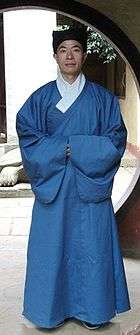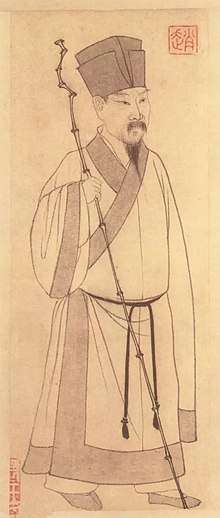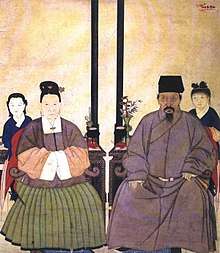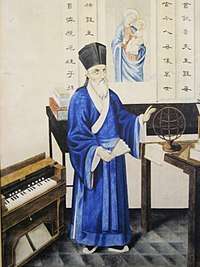Zhiduo (clothing)
Zhiduo (直裰; alternatively: 直掇, 直綴 and 直敠) refers to two traditional Chinese man's robes: casual zhiduo and priests’ zhiduo, in the broad sense.[1] Particularly the former in the narrow sense.[2]

Zhiduo, a man's casual robe, after medieval China
Casual zhiduo
The casual zhiduo was popular among Yuan and Ming dynasties, it could be worn by both scholar-official and the common people, and has several features[1]:
- The bottom of robe reaches below the knee
- With overlapping collar
- A through center back seam runs down the robe
- With lateral slit on each lower side
- Without hem or lan (襴; a decorative narrow panel encircling the robe, usually held in position below the knee)
Gallery for casual zhiduo
 Su Shi in zhiduo
Su Shi in zhiduo A Ming dynasty portrait illustrating a man wearing zhiduo, woman wearing banbi.
A Ming dynasty portrait illustrating a man wearing zhiduo, woman wearing banbi. Ming dynasty portrait of men wearing zhiduo
Ming dynasty portrait of men wearing zhiduo Ming dynasty portrait of men wearing zhiduo
Ming dynasty portrait of men wearing zhiduo Matteo Ricci in zhiduo
Matteo Ricci in zhiduo
Priests’ zhiduo
The priests’ zhiduo was generally worn by a Mahāyāna or Taoist priest, it had been popular since the Song dynasty, and has another several features[1]:
- With loose cuffs
- With black borders around the edges of robe
- With a lan on the waistline of robe
It is also known as jikitotsu (直綴; じきとつ) in Japan.[3]
gollark: I mean, it does say so in Christianity.
gollark: For life.
gollark: And I wouldn't trust anyone but me to be supreme eternal world dictator™.
gollark: Currently.
gollark: The state is at least *nominally* meant to respond to people's preferences and not the other way round.
See also
- Han Chinese clothing
- List of Han Chinese clothing
References
- 中国衣冠服饰大辞典 (in Chinese). 1996. pp. 158–9. ISBN 9787532602520.
- Zhu, Heping (2001). 中国服饰史稿 (in Chinese). pp. 222–3. ISBN 9787534820496.
- 第三版,世界大百科事典内言及, ブリタニカ国際大百科事典 小項目事典,デジタル大辞泉,世界大百科事典 第2版,大辞林. "直綴(じきとつ)とは - コトバンク". コトバンク (in Japanese). Retrieved 2018-07-28.
This article is issued from Wikipedia. The text is licensed under Creative Commons - Attribution - Sharealike. Additional terms may apply for the media files.